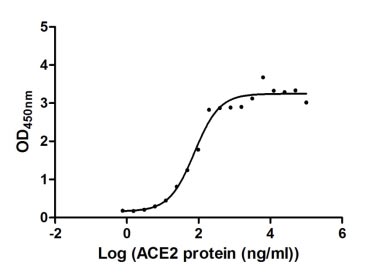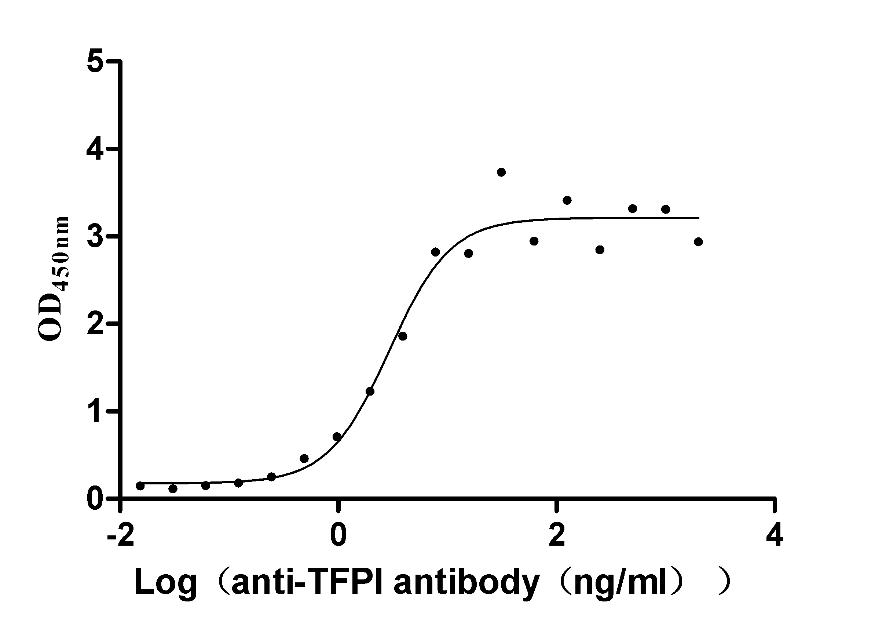Recombinant Mouse Lamina-associated polypeptide 2, isoforms alpha/zeta (Tmpo)
-
中文名稱:小鼠Tmpo重組蛋白
-
貨號:CSB-EP723396MO-B
-
說明書:
-
規格:
-
來源:E.coli
-
共軛:Avi-tag Biotinylated
E. coli biotin ligase (BirA) is highly specific in covalently attaching biotin to the 15 amino acid AviTag peptide. This recombinant protein was biotinylated in vivo by AviTag-BirA technology, which method is BriA catalyzes amide linkage between the biotin and the specific lysine of the AviTag.
-
其他:
產品詳情
-
純度:>85% (SDS-PAGE)
-
基因名:Tmpo
-
Uniprot No.:
-
別名:Tmpo; Lap2Lamina-associated polypeptide 2; isoforms alpha/zeta; Thymopoietin isoforms alpha/zeta; TP alpha/zeta
-
種屬:Mus musculus (Mouse)
-
蛋白長度:Full Length
-
表達區域:1-693
-
氨基酸序列MPEFLEDPSVLTKDKLKSELVANNVTLPAGEQRKDVYVQLYLQHLTARNRPPLAAGANSKGPPDFSSDEEREPTPVLGSGASVGRGRGAVGRKATKKTDKPRLEDKDDLDVTELSNEELLDQLVRYGVNPGPIVGTTRKLYEKKLLKLREQGTESRSSTPLPTVSSSAENTRQNGSNDSDRYSDNDEGKKKEHKKVKSARDCVPFSELASTPSGAFFQGISFPEISTRPPLGRTELQAAKKVQTTKRDPPRETCTDTALPGKGQTHKLAPGRSLFIPSESSYDRCVEKSSSPSSQREFAARLVSAAASPSLIRETTTTYSKDIVENICRGGKSRAQPLRAEEPGVSDQSVFSSEREVLQESERSQVISPPLAQAIRDYVNSLLVQGGVGSLPGTSDSVPTLDVENICKRLSQSSYQDSESLSPPRKVPRLSEKPARGGDSGSCVAFQNTPGSEHRSSFAKSVVSHSLTTLGVEVSKPPPQHDKIEASEPSFPLHESILKVVEEEWQQIDRQLPSVACRYPVSSIEAARILSVPKVDDEILGFISEATPRAATQASSTESCDKHLDLALCRSYEAAASALQIAAHTAFVAKSLQADISQAAQIINSDPSDAQQALRILNRTYDAASYLCDAAFDEVRMSACAMGSSTMGRRYLWLKDCKISPASKNKLTVAPFKGGTLFGGEVHKVIKKRGNKQ
-
蛋白標簽:Tag?type?will?be?determined?during?the?manufacturing?process.
The tag type will be determined during production process. If you have specified tag type, please tell us and we will develop the specified tag preferentially. -
產品提供形式:Lyophilized powder
Note: We will preferentially ship the format that we have in stock, however, if you have any special requirement for the format, please remark your requirement when placing the order, we will prepare according to your demand. -
復溶:We recommend that this vial be briefly centrifuged prior to opening to bring the contents to the bottom. Please reconstitute protein in deionized sterile water to a concentration of 0.1-1.0 mg/mL.We recommend to add 5-50% of glycerol (final concentration) and aliquot for long-term storage at -20℃/-80℃. Our default final concentration of glycerol is 50%. Customers could use it as reference.
-
儲存條件:Store at -20°C/-80°C upon receipt, aliquoting is necessary for mutiple use. Avoid repeated freeze-thaw cycles.
-
保質期:The shelf life is related to many factors, storage state, buffer ingredients, storage temperature and the stability of the protein itself.
Generally, the shelf life of liquid form is 6 months at -20°C/-80°C. The shelf life of lyophilized form is 12 months at -20°C/-80°C. -
貨期:Delivery time may differ from different purchasing way or location, please kindly consult your local distributors for specific delivery time.Note: All of our proteins are default shipped with normal blue ice packs, if you request to ship with dry ice, please communicate with us in advance and extra fees will be charged.
-
注意事項:Repeated freezing and thawing is not recommended. Store working aliquots at 4°C for up to one week.
-
Datasheet :Please contact us to get it.
靶點詳情
-
功能:May be involved in the structural organization of the nucleus and in the post-mitotic nuclear assembly. Plays an important role, together with LMNA, in the nuclear anchorage of RB1.
-
基因功能參考文獻:
- Lifespan and body mass were increased in Lmna(-/-)Lap2alpha(-/-) mice compared with Lmna deficient mice. PMID: 23535822
- Data indicate that a LAP2alpha-independent assembly defect of DeltaK32 lamin A/C is the cause of the pathology, whereas the LAP2alpha-linked functions of nucleoplasmic lamin A/C in the regulation of tissue progenitor cells are not affected in Lmna(DeltaK32/DeltaK32) mice. PMID: 23444379
- LAP2alpha serves as a transcriptional co-regulator, which controls muscle specific gene expression during muscle regeneration, muscle remodeling and stress response. PMID: 21326822
- TSLP diverts airway tolerance against ovalbumin (OVA) to T helper cell type (Th)2 sensitization and inhibits the generation of OVA-specific inducible regulatory T cells. PMID: 21242516
- The age-related down-regulation of Wnt4 (and subsequently FoxN1), and the prominent increase in LAP2alpha expression, was investigated in thymic epithelial cells. PMID: 20502698
- Our data demonstrate multiple and distinct functions of LAP2 alpha in muscle stem cell maintenance, early phases of myogenic differentiation, and muscle remodeling. PMID: 20039368
- Data show that LAP2alpha knockout caused systolic dysfunction in young mice, sporadic fibrosis in old animals, and disregulation of cardiac GATA4 and MEF2c, while dstrophin deficiency in Mdx mice resulted in a transient rescue of Lap2alpha(-/-) phenotype. PMID: 19926876
- In agreement with its regulation by E2F, LAP2alpha over expression in primary tumors was found to be correlated with tumor proliferation rate PMID: 16760672
- LAP2alpha is dispensable for murine leukemia infections. PMID: 18400857
- Loss of LAP2-Lmna complexes causes erythroid and epidermal progenitor hyperproliferation. PMID: 18849980
顯示更多
收起更多
-
亞細胞定位:Nucleus. Chromosome.
-
蛋白家族:LEM family
-
數據庫鏈接:
STRING: 10090.ENSMUSP00000020123
UniGene: Mm.159684
Most popular with customers
-
Recombinant Human Angiotensin-converting enzyme 2 (ACE2), partial (Active)
Express system: Mammalian cell
Species: Homo sapiens (Human)
-
Recombinant Human Poliovirus receptor (PVR) (I340M), partial (Active)
Express system: Mammalian cell
Species: Homo sapiens (Human)
-
Recombinant Rabbit Tissue factor pathway inhibitor (TFPI) (Active)
Express system: Mammalian cell
Species: Oryctolagus cuniculus (Rabbit)
-
Recombinant Mouse Claudin-18.2 (Cldn18.2)-VLPs (Active)
Express system: Mammalian cell
Species: Mus musculus (Mouse)
-
Recombinant Human Dickkopf-related protein 1 (DKK1) (Active)
Express system: Mammalian cell
Species: Homo sapiens (Human)
-
Recombinant Human Serine/threonine-protein kinase receptor R3 (ACVRL1), partial (Active)
Express system: Baculovirus
Species: Homo sapiens (Human)
-
Recombinant Human Myosin regulatory light chain 12A (MYL12A) (Active)
Express system: E.coli
Species: Homo sapiens (Human)
-
Express system: Mammalian cell
Species: Homo sapiens (Human)



-AC1.jpg)

-AC1.jpg)
-AC1.jpg)













